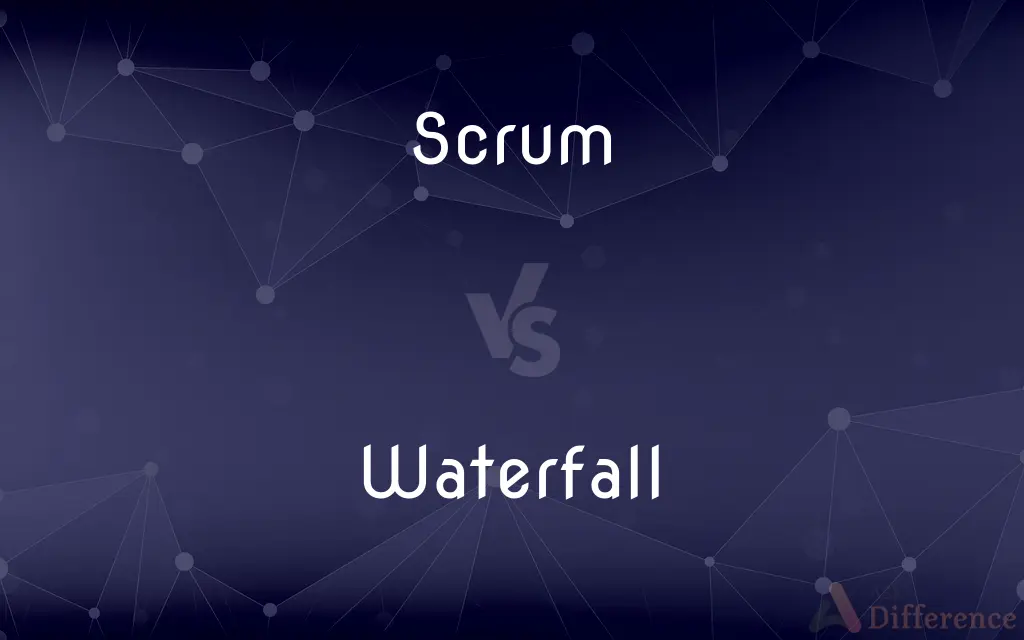Scrum vs. Waterfall — What's the Difference?
By Fiza Rafique & Urooj Arif — Updated on May 13, 2024
Scrum is an agile framework emphasizing iterative progress through short sprints, whereas Waterfall is a linear, sequential approach, planning the entire project upfront.

Difference Between Scrum and Waterfall
Table of Contents
ADVERTISEMENT
Key Differences
Scrum encourages flexibility and rapid iteration, with projects divided into sprints, typically lasting two to four weeks. On the other hand, Waterfall involves a structured, sequential design process where each phase must be completed before the next begins, leaving little room for revisiting earlier stages.
In Scrum, teams work in collaborative, cross-functional groups and daily stand-up meetings to adapt to changes quickly. Whereas, Waterfall teams often work in silos with defined roles and phases (e.g., analysis, design, coding, testing), making it difficult to respond swiftly to changes.
Feedback and testing in Scrum are continuous, occurring at the end of each sprint during the sprint review and retrospective. In contrast, in Waterfall, testing typically happens only after the build phase is complete, which can delay the detection of issues.
Scrum allows for changes in project scope or direction based on stakeholder input and sprint reviews. On the other hand, Waterfall's initial requirements and scope are fixed from the start, making changes costly and time-consuming.
The end product in Scrum is potentially shippable after each sprint, allowing for gradual improvement and adaptation. Conversely, in Waterfall, the final product is not seen until the end of the project, which can lead to a higher risk of the end product not meeting user expectations.
ADVERTISEMENT
Comparison Chart
Approach
Iterative and incremental
Linear and sequential
Flexibility
High flexibility with changes allowed at many points
Low flexibility with changes difficult post-planning
Team Structure
Cross-functional and collaborative
Typically departmental and siloed
Feedback and Testing
Continuous throughout sprints
Generally occurs after the build phase
Risk Management
Lower risk due to frequent reassessments
Higher risk due to late testing and fixed plans
Compare with Definitions
Scrum
An agile framework that facilitates team collaboration on complex projects.
A software development team using Scrum might deliver new features every two weeks.
Waterfall
Each phase depends on the deliverables of the previous one.
The design phase in Waterfall cannot begin until the analysis phase is complete.
Scrum
Emphasizes iterative progress through sprints.
Each sprint in Scrum concludes with a review to discuss improvements.
Waterfall
Incorporates a fixed structure and timeline.
Changes in the project scope are not encouraged once the project has begun.
Scrum
Adapts to changes quickly through regular feedback.
Changes in user requirements are integrated in the next sprint planning.
Waterfall
Testing is conducted after the build phase.
In Waterfall, system testing is done after the entire system is built.
Scrum
Focuses on continuous improvement.
Retrospectives are held after each sprint to refine processes.
Waterfall
A sequential design process used in software development.
A project using Waterfall methodology might have distinct phases that follow one after another.
Scrum
A play in rugby in which the two sets of forwards mass together around the ball and, with their heads down, struggle to gain possession of the ball.
Waterfall
Requires detailed planning and documentation upfront.
The Waterfall model begins with extensive requirement analysis before any coding starts.
Scrum
The mass or formation of players during such a play.
Waterfall
A waterfall is an area where water flows over a vertical drop or a series of steep drops in the course of a stream or river. Waterfalls also occur where meltwater drops over the edge of a tabular iceberg or ice shelf.
Scrum
Chiefly British A disordered or confused situation involving a number of people.
Waterfall
A cascade of water falling from a height, formed when a river or stream flows over a precipice or steep incline.
Scrum
To engage in a scrum.
Waterfall
Relating to or denoting a method of project management that is characterized by sequential stages and a fixed plan of work
Each phase of a waterfall project must be complete prior to moving to the next phase
Scrum
A tightly-packed and disorderly crowd of people.
A scrum developed around the bar when free beer was announced.
Waterfall
A steep descent of water from a height; a cascade.
Scrum
(Canada) A tightly packed group of reporters surrounding a person, usually a politician, asking for comments about an issue; an opportunity provided for a politician to be approached this way.
A scrum formed around Scott Brison in the House of Commons lobby shortly after he announced his candidacy for the federal Liberal leadership.
Waterfall
A flow of water over the edge of a cliff.
Scrum
(rugby) In rugby union or rugby league, all the forwards joined together in an organised way.
Waterfall
(figuratively) A waterfall-like outpouring of liquid, smoke, etc.
A waterfall of mist came from the open freezer.
Scrum
(software engineering) In Agile software development (specifically Scrum or related methodologies), a daily meeting in which each developer describes what they have been doing, what they plan to do next, and any impediments to progress.
Waterfall
Waterfall model
A very long duration project ... had taken a whole group of people through a painful waterfall development process.
Scrum
Hostile shoving between two groups.
Waterfall
The action of drinking from a vessel without touching it with the lips, considered more sanitary for a shared vessel.
Hey man, can I take a waterfall from your bottle?
Scrum
To form a scrum.
Waterfall
A necktie.
Scrum
(software engineering) Scrum
Waterfall
A chignon.
Scrum
(rugby) the method of beginning play in which the forwards of each team crouch side by side with locked arms; play starts when the ball thrown in between them and the two sides compete for possession
Waterfall
A beard.
Scrum
Involves roles such as Scrum Master and Product Owner.
The Scrum Master facilitates sprint planning meetings to ensure team alignment.
Waterfall
(intransitive) To fall like a waterfall.
Waterfall
(transitive) To drink (something) from a container by pouring it from a height so as not to touch one's lips to the rim.
Waterfall
(roller derby) recycle
Waterfall
A fall, or perpendicular descent, of the water of a river or stream, or a descent nearly perpendicular; a cascade; a cataract.
Waterfall
An arrangement of a woman's back hair over a cushion or frame in some resemblance to a waterfall.
Waterfall
A certain kind of neck scarf.
Waterfall
A steep descent of the water of a river
Common Curiosities
Which methodology allows for continuous improvement?
Scrum encourages continuous improvement through regular retrospectives.
What roles are specific to Scrum?
Roles like Scrum Master and Product Owner are specific to Scrum.
Can Waterfall accommodate changes easily?
No, changes in Waterfall are challenging due to its structured nature.
Is Waterfall suitable for all types of projects?
Waterfall is best suited for projects with clear, unchanging requirements.
Which methodology is better for large, complex projects?
Scrum is generally better for large, complex projects that require flexibility.
How does feedback occur in Waterfall compared to Scrum?
In Waterfall, feedback is typically limited to the end of the project, unlike the continuous feedback in Scrum.
What is the main difference between Scrum and Waterfall?
Scrum is iterative and flexible, while Waterfall is linear and structured.
How do teams operate differently in Scrum vs. Waterfall?
Scrum teams are collaborative and cross-functional, whereas Waterfall teams often work in silos.
How do Scrum and Waterfall handle project documentation?
Waterfall requires extensive documentation upfront, while Scrum maintains lighter, ongoing documentation.
What is at risk with using Waterfall in today’s fast-paced environments?
The lack of flexibility can make it difficult to adapt to changes, potentially leading to irrelevant products.
Is Scrum more resource-intensive than Waterfall?
Scrum can be more resource-intensive due to its collaborative and iterative nature.
How are project timelines different in Scrum and Waterfall?
Scrum has flexible timelines with sprints, whereas Waterfall follows a fixed schedule.
Why might a company choose Waterfall over Scrum?
A company might choose Waterfall for projects with well-defined stages and stable requirements.
How do testing phases differ between Scrum and Waterfall?
Testing in Scrum is integrated throughout development, while in Waterfall, it typically occurs after the build phase.
Which methodology is more suited to software development today?
Scrum is more suited to modern software development due to its adaptability.
Share Your Discovery

Previous Comparison
Maya vs. Blender
Next Comparison
AM vs. FMAuthor Spotlight
Written by
Fiza RafiqueFiza Rafique is a skilled content writer at AskDifference.com, where she meticulously refines and enhances written pieces. Drawing from her vast editorial expertise, Fiza ensures clarity, accuracy, and precision in every article. Passionate about language, she continually seeks to elevate the quality of content for readers worldwide.
Co-written by
Urooj ArifUrooj is a skilled content writer at Ask Difference, known for her exceptional ability to simplify complex topics into engaging and informative content. With a passion for research and a flair for clear, concise writing, she consistently delivers articles that resonate with our diverse audience.













































